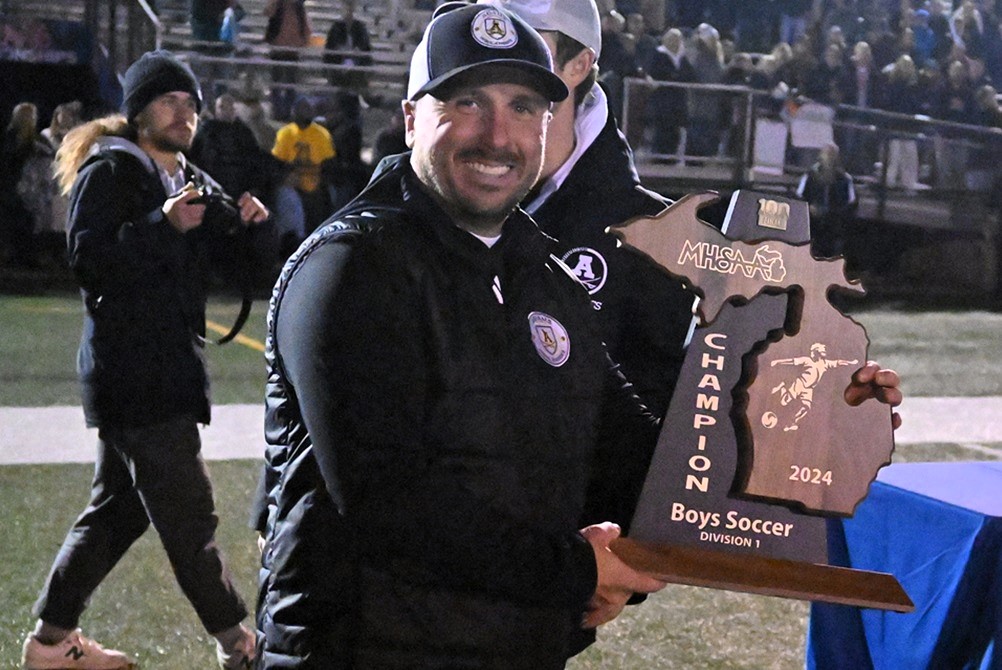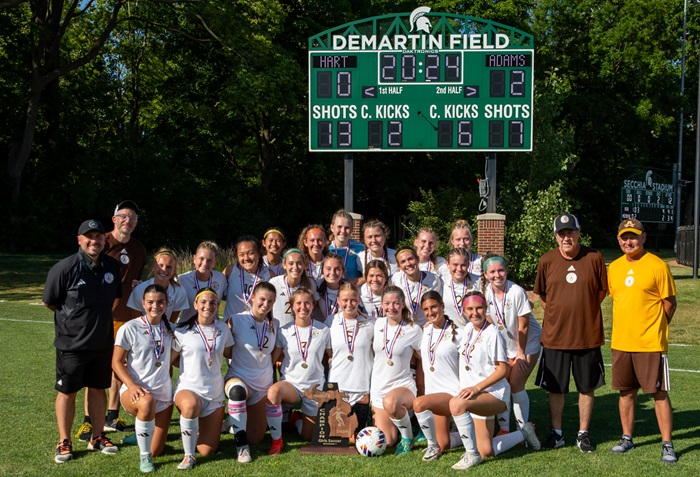
'Hearts' Focus Includes Action Planning
November 12, 2015
By Geoff Kimmerly
Second Half editor
As most of Michigan’s high school athletes move inside this month for the start of winter sports, many will take part in a program introduced to Michigan High School Athletic Association member schools this fall that assists coaches and students in preparing for the possibility of a health emergency during their after-school practices and events.
Prior to the start of this 2015-16 school year, the MHSAA sent every member school the “Anyone Can Save a Life” emergency action plan authored by the Minnesota State High School League and the Medtronic Foundation. The program instructs schools to assemble teams made up of coaches and their students that will act in the event someone suffers sudden cardiac arrest or another emergency medical situation.
“Anyone Can Save a Life” suggests a game plan that establishes four teams on every level of every sport in a school – a 911 Team, CPR (cardiopulmonary resuscitation) Team, AED (automated external defibrillator) Team and Heat Stroke Team. The groups are made up of coaches and their students who will be in close proximity to all after-school activities.
It’s another valuable tool as the MHSAA begins work on the fourth piece of its eight-year “4 H’s” health and safety emphasis. The next two school years focus on Hearts to go with efforts over the last six years centered on Health Histories, Heads and Heat issues faced by MHSAA athletes. This fall, for the first time, all varsity head coaches at MHSAA member schools were required to have CPR certification – another means by which athletic personnel can work to counter the random, unpredictable nature of sudden cardiac arrest.
“There is something we can do. We can be prepared. We can develop emergency plans, display AEDs and deliver CPR. And, like any good sports teams, we need to practice our preparations,” MHSAA Executive Director John E. “Jack” Roberts said. “’Anyone Can Save a Life’ can help schools revise or revitalize their existing emergency plans in ways that engage team members in planning, practice and execution. This could help save lives now and also convey important lifelong life-saving lessons to students involved on these teams.”
Students are a vital component to having a successful emergency action plan. They will be put in position to call 911, meet the ambulance at a pre-determined access point, locate the nearest AED, make sure immersion tubs are filled for hot-weather practices, and for those who are trained, to assist with CPR. Coaches identify students at the beginning of the season and prior to an emergency taking place, and provide them with the details of the job they are assigned so they will be ready to assist in the event of an emergency.
The “Anyone Can Save a Life” plan was sent to schools nationwide with assistance from the National Federation of State High School Associations and the NFHS Foundation. Click for information on "Anyone Can Save a Life."
“The ‘Anyone Can Save a Life’ initiative promotes the need to have and to practice planning for different kinds of emergencies,” Roberts said. “The result can be a fresh, comprehensive emphasis on preparing for emergencies well before they occur and then responding with more confidence when those emergencies inevitably happen. It is the perfect link between the last two years when we focused on heat illness and the next two years when we focus on sudden cardiac arrest.”
This fall’s focus on “Hearts” began in the wake of 122 Michigan schools receiving recognition this spring as HEARTSafe by the Michigan Department of Health and Human Services, Michigan Department of Education, American Heart Association, Michigan Alliance for Prevention of Sudden Cardiac Death of the Young and the MHSAA.
Public Act 12 of 2014 requires all schools (grades kindergarten to 12) to have a cardiac emergency response plan in place. This MI HEARTSafe School designation recognizes 122 schools that have taken steps above and beyond to prepare to respond in the event of a cardiac emergency, and is awarded for a period of three years.
In order for a school to receive MI HEARTSafe designation, it must perform at least one cardiac emergency response drill per year, have a written medical emergency response plan and team, have current CPR/AED certification of at least 10 percent of staff, have accessible, properly maintained and inspected AEDs with signs identifying their location, and ensure pre-participation sports screening of all student-athletes using the current physical and history form endorsed by the MHSAA.
Schools that meet all requirements are able to apply for the MI HEARTSafe School designation each year. Click for information and for a list of designated schools.

Hickey Joins Notable Coaching Crew as Adams Completes 2024 Soccer Sweep
By
Keith Dunlap
Special for MHSAA.com
November 14, 2024
When New Year’s Eve comes this year and the ball drops to welcome in 2025, Rochester Adams boys and girls soccer coach Josh Hickey might be hesitant to celebrate this year coming to an end.
 It’s not that he won’t be excited for the new year. It’s just that it might be impossible to top 2024 from a coaching perspective.
It’s not that he won’t be excited for the new year. It’s just that it might be impossible to top 2024 from a coaching perspective.
In June, Hickey made history when he helped guide the Adams girls to the Division 1 championship with a 2-0 win over Hartland.
He joined the list of soccer coaches in state history who have led both boys and girls programs to Finals championships, a group that includes Barry Brodsky of Bloomfield Hills Marian/Brother Rice, Randy Heethuis of Hudsonville Unity Christian, Brian Guggemos of Okemos, Ken Johnson of Salem, Brian O’Leary of Novi, Tim Storch of Troy Athens and Clark Udell of Grand Rapids Forest Hills Central.
“That’s good company to keep, that’s for sure,” Hickey said in praising those other coaches who have pulled off the feat.
Earlier this month, the Adams boys followed in the footsteps of their classmates from this spring, defeating Byron Center in the Division 1 Final, 2-0, to win the program’s second Division 1 title over the last three years. Adams downed Rockford in the 2022 Final, also by a 2-0 score.
Adams also won girls and boys Division 1 soccer titles during the same calendar year in 1999, but with those teams led by separate coaches.
Hickey said while each team had talent and players all came from great soccer backgrounds and families, the two championship runs were quite different.
“With the girls, I would imagine nobody picked us necessarily to go that far, especially at the beginning of the season,” he said. “Throughout the year, the girls were just super resilient. The expectation wasn’t there.”
It was a far different element once the fall started and the boys took the field, given there was a solid core of returnees and also five MLS Next academy players who decided to experience high school soccer for their senior year, including eventual Mr. Soccer Award winner Alex Rosin.
 “With the boys, we had to battle through all those expectations,” Hickey said. “There is something with your mental toughness to see if the kids can even handle that pressure. They handled it better than I thought they would. It was never a concern or issue.
“With the boys, we had to battle through all those expectations,” Hickey said. “There is something with your mental toughness to see if the kids can even handle that pressure. They handled it better than I thought they would. It was never a concern or issue.
“The girls came in and just wanted a good year and then ended up having the most success they could ever imagine. The boys came in telling me they wanted to win the whole thing from day one.”
On Oct. 30 – when the Adams boys team defeated Saline in their Semifinal (2-1 in penalty kicks) – it just so happened to be the same day the girls team got its championship rings.
“Some of the girls came and showed us during lunch and throughout the day,” Rosin said. “It just gave us extra motivation. We had to win two more, and we successfully did. At the time, we wanted it so bad and we saw them wear the rings at school. It made us want it even more.”
For the record, Rosin said playing high school soccer — even if it was just for one year — was an experience he’ll never forget.
“Hickey played me at every position,” Rosin said. “It was a good experience to learn the game in a different way. Just kind of push myself and test myself every day. Different positions and trying to become the best player I can be.
“One thing I’ll take away is the memories and new bonds I made with my teammates. It was something incredible.”
Despite the boys season being over, Hickey said the transition to girls season will wait a bit. There is still the matter of the postseason banquet to attend to, as well as championship celebrations such as meeting the mayor of Rochester Hills and marching in the downtown Rochester Christmas parade.
But once the celebrations slow down and the holidays come to end, all attention will turn to the girls season and the run for a repeat next spring.
The Adams girls program has never won consecutive Finals titles, but should be well-equipped to give it a go.
“A lot of players come back from the starting group,” Hickey said. “We also had girls waiting in the wings waiting to play. We’re excited for it.”
While it will be difficult for Hickey and Adams soccer to say farewell to 2024, there clearly is a lot to look forward to for 2025 as well.
 Keith Dunlap has served in Detroit-area sports media for more than two decades, including as a sportswriter at the Oakland Press from 2001-16 primarily covering high school sports but also college and professional teams. His bylines also have appeared in USA Today, the Washington Post, the Detroit Free Press, the Houston Chronicle and the Boston Globe. He served as the administrator for the Oakland Activities Association’s website from 2017-2020. Contact him at [email protected] with story ideas for Oakland, Macomb and Wayne counties.
Keith Dunlap has served in Detroit-area sports media for more than two decades, including as a sportswriter at the Oakland Press from 2001-16 primarily covering high school sports but also college and professional teams. His bylines also have appeared in USA Today, the Washington Post, the Detroit Free Press, the Houston Chronicle and the Boston Globe. He served as the administrator for the Oakland Activities Association’s website from 2017-2020. Contact him at [email protected] with story ideas for Oakland, Macomb and Wayne counties.
PHOTOS (Top) Rochester Adams soccer coach Josh Hickey shows the Division 1 championship trophy after his boys team defeated Byron Center on Nov. 2 at Grand Ledge High School. (Middle) Hickey, far left, takes his spot in the team photo after Adams’ girls won the Division 1 title in June at Michigan State’s DeMartin Stadium.

